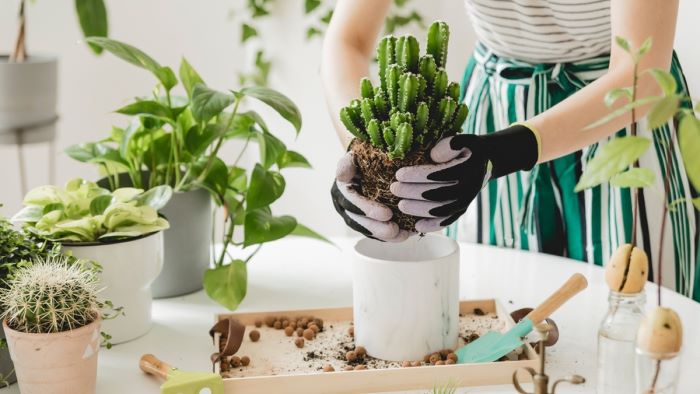Have you ever dreamed of having your own home garden where you can grow fresh fruits, vegetables, herbs, and flowers? Do you want to enjoy the benefits of gardening such as saving money, eating healthier, reducing stress, and beautifying your space? If you answered yes to any of these questions, then this blog post is for you!
Gardening is a fun and rewarding hobby that anyone can do, regardless of their experience level, budget, or space availability. All you need is some basic knowledge, tools, and materials to get started. In this beginner’s guide, we will show you how to start a home garden from scratch in 10 easy steps. By following these steps, you will be able to create a successful garden that suits your needs and preferences.
Let’s get started!
Steps to Create Gardens in Your Yard for the First Time
If you are new to gardening, you may feel overwhelmed by the amount of work and planning involved. However, with some basic steps and tips, you can create a successful garden in your yard for the first time. Here are 10 steps to help you get started:
1. Decide What to Plant

The first step is to decide what kind of garden you want to create. Do you want to grow flowers, vegetables, herbs, fruits, or a mix of them? Think about your goals, preferences, and available space. You may also want to consider the seasonality, maintenance, and harvest time of different plants.
For example, if you want to enjoy fresh salads throughout the summer, you may want to plant lettuce, spinach, tomatoes, and cucumbers. If you want to add some color and fragrance to your yard, you may want to plant roses, lavender, or sunflowers.
2. Determine Climate Zone
The next step is to determine your climate zone, which is based on the average minimum winter temperature in your area. Knowing your climate zone will help you choose plants that are suitable for your region and can survive the weather conditions. You can find your climate zone by using online tools such as the USDA Plant Hardiness Zone Map or the Sunset Climate Zone Finder. Alternatively, you can ask your local nursery or extension office for advice.
3. Pick the Garden Spot

Once you know what to plant and your climate zone, you need to pick a spot in your yard for your garden. Ideally, you want a spot that gets at least six hours of direct sunlight per day, has good drainage, and is protected from strong winds and pests. You also want to consider the size and shape of your garden bed, as well as the accessibility and visibility of your garden.
For example, if you are growing vegetables or herbs, you may want to place your garden near your kitchen or patio for convenience. Similarly, if you are growing flowers, you may want to place your garden along a walkway or fence for aesthetic appeal.
4. Clear the Ground Area
Before you can plant anything in your garden spot, you need to clear the ground area of any weeds, grasses, rocks, or debris that may compete with or damage your plants. You can use a shovel, a hoe, or a tiller to dig up the soil and remove any unwanted materials. You may also want to use a rake or a leveler to smooth out the surface and create an even slope for drainage.
5. Get the Basic Gardening Tools

To create and maintain your garden, you will need some basic gardening tools, which will make your work easier and more efficient. Some of the essential tools include:
- A spade or shovel for digging holes and moving soil
- A trowel for planting small plants or seeds
- A rake for leveling the soil and removing debris
- A hoe for weeding and cultivating the soil
- A watering can or hose for watering your plants
- A pair of pruning shears for trimming and shaping your plants
- A pair of gloves to protect your hands
- A wheelbarrow for transporting soil or compost
6. Test the Soil
One of the most important factors that affect the health and growth of your plants is the quality of your soil. Different plants have different preferences for soil pH (acidity or alkalinity), texture (clayey, sandy, or loamy), and fertility (nutrient content). To ensure that your soil meets the needs of your plants, you should test it before planting anything in it. You can use a home testing kit or send a sample to a laboratory for analysis. Based on the results, you can amend your soil with organic matter such as compost, manure, peat moss, or leaf mold to improve its structure and nutrient level. You can also adjust its pH with lime (to raise it) or sulfur (to lower it).
7. Make Your Garden Bed
After preparing your soil, you can make your garden bed by marking its boundaries with stakes or strings and digging it up to a depth of about 12 inches. You can shape your bed into any form that suits your space and style such as rectangular, square, circular, or curved. You can also create raised beds by building wooden frames or using bricks or stones to elevate your bed above ground level. Raised beds have several advantages such as better drainage, warmer soil temperature, easier access, and fewer weeds.
8. Pick Your Plants or Seeds
Now that you have made your garden bed, you can pick your plants or seeds to fill them with life and color. You can buy plants from nurseries or online stores that offer a wide variety of species and varieties that are suitable for your climate zone and garden type. You can also grow plants from seeds by sowing them directly in the ground or starting them indoors in pots or trays before transplanting them outside when they are ready. Growing plants from seeds is cheaper and more rewarding than buying plants, but it also requires more time and care.
9. Water Sufficiently

Watering is one of the most essential tasks in gardening. As it ensures that your plants get enough moisture to survive and thrive. However, watering too much or too little can be harmful to your plants as it can cause root rot or drought stress respectively. To water properly, you should follow these tips:
- Water deeply but infrequently rather than shallowly but frequently
- Water early in the morning or late in the evening rather than during midday when evaporation is high
- Water at the base of the plant rather than overhead to avoid wetting the foliage which can lead to fungal diseases
- Water according to the needs of each plant rather than following a fixed schedule as different plants have different water requirements
- Use a rain gauge or a moisture meter to monitor how much water your plants receive from rainfall or irrigation
10. Protect Your Garden With Mulch
The final step in creating your garden is to protect it with mulch, which is any material that covers the soil surface around your plants such as straw, wood chips, pine needles, leaves, grass clippings etc… Mulching has many benefits such as:
- Conserving soil moisture by reducing evaporation
- Suppressing weeds by blocking sunlight
- Moderating soil temperature by insulating it from heat or cold
- Enriching soil fertility by decomposing into organic matter
- Enhancing aesthetic appeal by adding color and texture
To mulch effectively, you should apply a layer of about 2 to 4 inches thick around your plants leaving some space around their stems to prevent rotting. You should also replenish mulch periodically as it breaks down over time.
Congratulations! You have just created a beautiful garden in your yard for the first time! Enjoy watching it grow and bloom with pride and joy!
FAQs
How do you start a food garden from scratch?
To start a food garden from scratch, you must find a sunny spot with good drainage. The second step is removing any weeds or grass and adding compost and fertilizer to the soil. Then, plan your layout and crop rotation, transplant your plants, and protect them from pests and diseases.
What are the best veggies to grow for beginners?
Some of the best veggies to grow for beginners are lettuce, radishes, tomatoes, cucumbers, beans, carrots, and zucchini. These veggies are easy to grow, require minimal care, and produce abundant harvests.
How to start a garden bed from a lawn?
To start a garden bed from a lawn, first choose a sunny area. Then, check for buried utility lines and mark off the area with paint. Lastly, kill the existing vegetation with newspaper and add compost and mulch to the soil. Then, you are all set to start your garden bed from the lawn.
How do I start a garden with no money?
If you want to start a garden without money, you can ask your friends and neighbors for seeds and cuttings from their plants. You can also borrow free fertilizer from compost, manure, or coffee grounds. In this way, you can easily start your garden without investing any money in the initial stage.
Well, It’s a Wrap!
Concluding our blog on How to Start a Home Garden: A Beginner’s Guide!
Let’s quickly recall it.
You don’t need a lot of space, time, or money to start a home garden. All you require is a sunny spot, some good soil, and a few seeds or plants. All you require is some basic knowledge, planning, and preparation. As we learned, to start a home garden from scratch, you need to choose a suitable location, prepare the soil, select the crops, plant the seeds or seedlings, water, and weed regularly. By following these steps, you will be able to create a beautiful and productive home garden that will bring you joy and satisfaction for years to come.
Gardening is not only fun and relaxing but also good for your health and the environment.

Hi, I’m Jacqueline, the editor-in-chief of cozynest. I have a passion for plants and gardening, also, have a degree in horticulture from the University of California, Davis. I love to share my knowledge and experience with our readers and help them create beautiful and healthy gardens, indoors, and outdoors. I also enjoy experimenting with different plant varieties, designs, and techniques, and learning from other experts in the field. When I’m not working on cozynest, you can find me in my own cozy nest, surrounded by my favorite plants and books.

